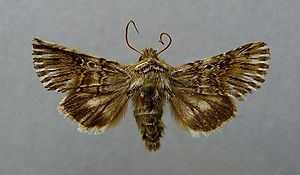Huebner's snapdragon owl
| Huebner's snapdragon owl | ||||||||||||
|---|---|---|---|---|---|---|---|---|---|---|---|---|

Huebner's snapdragon owl ( Omphalophana antirrhinii ) |
||||||||||||
| Systematics | ||||||||||||
|
||||||||||||
| Scientific name | ||||||||||||
| Omphalophana antirrhinii | ||||||||||||
| ( Huebner , 1803) |
Hübner's snapdragon owl ( Omphalophana antirrhinii ) is a butterfly ( moth ) from the owl butterfly family (Noctuidae). The German name honors the Augsburg entomologist Jacob Hübner .
features
butterfly
The basic color of the forewings varies in different shades of brown. Ring and kidney flaws are small, but clearly highlighted and usually have a light border, cone flaws are missing. The inner transverse line is double. The broadly dusted white veins in the border area are very characteristic. Some black lines can be seen in the post-fiscal region . With a wingspan of 26 to 32 millimeters, the adults are one of the smaller owl butterfly species. The hind wings are colored gray and show a broad, dark fringing field. The sawtooth-like antennae of the males are also characteristic .
Caterpillar, pupa
Adult caterpillars are greenish in color. They have white-yellow back and side back lines and yellowish side stripes. Two short tips on the spatula-shaped cremaster are typical of the red-brown colored doll .
Similar species
The coloration of the sister species Omphalophana durnalayana , which occurs in eastern Turkey, tends to be more ocher-brown, while Omphalophana serrata and Omphalophana anatolica differ by a narrower and more darkened middle field of the forewings.
Geographical distribution and habitat
The distribution area of Hübner's snapdragon owl includes the countries of southern Europe, parts of Asia Minor and the Middle East as well as the Elburs Mountains . The species occurs mainly on stony southern slopes, sandy and dry grass areas or steppe areas.
Way of life
The moths are active both during the day and at night. During the day they visit the flowers of various composites ( Compositae ) and in the evening they like to come to artificial light sources . They fly in two generations from April to June and July to August. The caterpillars prefer to feed on the flowers and seeds of various snapdragon ( Antirrhinum ), toadflax ( Linaria ), scabiosa ( Scabiosa ) or scale head species ( Cephalaria ). The species overwinters as a pupa.
Danger
Hübner's snapdragon owl is not at home in Germany. Older information about an occurrence in Bavaria is doubtful.
swell
literature
- Gábor Ronkay & Lázló Ronkay: Cucullinae II . In: Michael Fibiger, Martin R. Honey, W. Gerald Tremevan (Eds.): Noctuidae Europaeae . tape 7 . Entomological Press, Sorø 1995, ISBN 87-89430-04-2 (English).
- Walter Forster , Theodor A. Wohlfahrt : The butterflies of Central Europe. Volume 4: Owls. (Noctuidae). Franckh'sche Verlagshandlung, Stuttgart 1971, ISBN 3-440-03752-5 .
Individual evidence
- ↑ a b c d Gábor Ronkay & Lázló Ronkay: Cucullinae II . In: Michael Fibiger, Martin R. Honey, W. Gerald Tremevan (Eds.): Noctuidae Europaeae . tape 7 . Entomological Press, Sorø 1995, ISBN 87-89430-04-2 (English).
- ↑ Walter Forster, Theodor A. Wohlfahrt: The butterflies of Central Europe. Volume 4: Owls. (Noctuidae). Franckh'sche Verlagshandlung, Stuttgart 1971, ISBN 3-440-03752-5 .
- ↑ Federal Agency for Nature Conservation (Ed.): Red List of Endangered Animals in Germany . Landwirtschaftsverlag, Münster 1998, ISBN 3-89624-110-9 .
Web links
- Lepiforum eV photos
- www.schmetterlinge-deutschlands.de Endangerment
- Omphalophana antirrhinii in Fauna Europaea